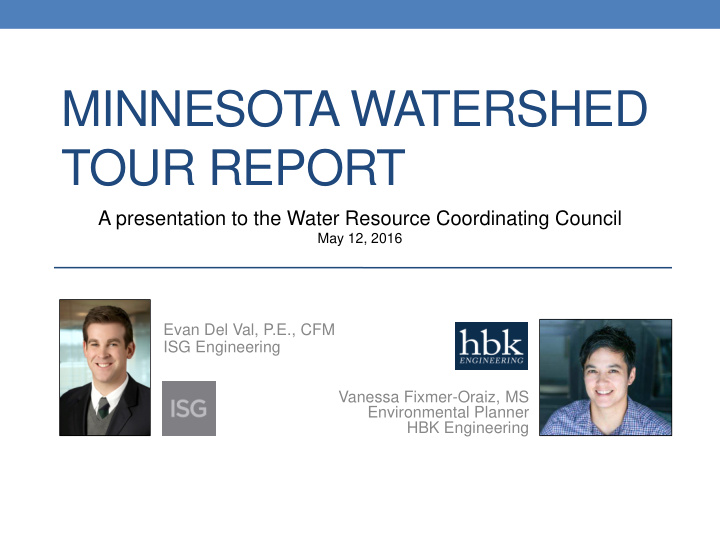



MINNESOTA WATERSHED TOUR REPORT A presentation to the Water Resource Coordinating Council May 12, 2016 Evan Del Val, P.E., CFM ISG Engineering Vanessa Fixmer-Oraiz, MS Environmental Planner HBK Engineering
Outline Our Watershed Tour History to Minnesota Water Quality Improvements Wastewater Treatment Plant lawsuit Constitutional referendum 3/8% tax Minnesota Plan One Watershed One Plan WRAPS 10 year assessment Sampling/monitoring/modeling 80 HUC-8 watersheds Similarities with Iowa Knowledge base Will Nutrient problems Differences with Iowa Funding
Our Tour Route & Agenda Day 1: Squaw Creek WMA Drainage research & Wetland projects Day 2: St. Paul State Building Presentations from state agencies • MN Board of water and Soil Resources • MN Pollution Control Agency • MN Department of Agriculture • MN Representatives Day 2: Tour of MN Agencies • Dakota SWCD • Dodge County Enviro Services • Cedar River Watershed District
Tour Stops Erv Klass, Squaw Creek champion 50-foot Creek buffer, Dakota County MN
Legislative Meeting
History of Legislative WQ Improvements • 2002: Legislative Audit found lack of progress identifying, evaluating and restoring impaired waters • 2003: Private and Public sectors (businesses, agriculture, environmental groups, local governments) began discussing pathway to cleaner water • 2005: MN Court of Appeals blocked the wasterwater permit for the cities of Annandale-Maple Lake, citing impaired waters section CWA • 2006: Clean Water Legacy Act enacted • 2008: Clean Water, Land and Legacy Amendment
Clean Water, Land and Legacy Amendment Historic vote in 2008 3/8ths of 1 percent sales tax increase for 25 years Clean Less than 4 cents on a Outdoor Water 33% $10 purchase 33% Amendment to MN constitution Yes: 56% No: 39% Arts 19.75% Parks & Trails 14.25%
The Watershed Framework Ongoing Local Implementation Comprehensive Watershed Monitoring and Examine water quality Management Assessment Identify stressors Plan Inform Watershed Restoration and Protection Strategies (WRAPS) Track trends for effectiveness Connecting state programs with local leadership Restoration and Characterization Protection & Problem Strategy and Investigation Development
Watershed Restoration and Protection Strategies (WRAPS) Watershed Plan: Summarizes Information, Diagnostics and Identifies Strategies for action • Summarize water quality condition • Reports stressors to the fish and invertebrate communities • Identifies and compares sources • Identifies pollution reduction necessary to achieve beneficial uses (TMDLs) • Identifies priority areas for targeting action • Sets milestones
Similarities & Differences
Commonalities Iowa & Minnesota Nutrient Strategies
Recommend
More recommend